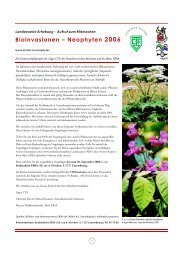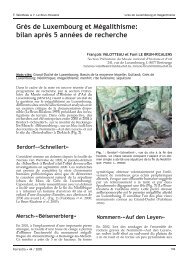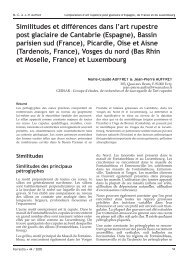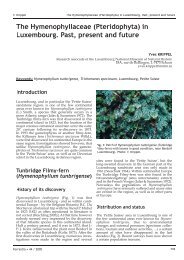Genetic variation in an isolated population of Hymenophyllum ...
Genetic variation in an isolated population of Hymenophyllum ...
Genetic variation in an isolated population of Hymenophyllum ...
You also want an ePaper? Increase the reach of your titles
YUMPU automatically turns print PDFs into web optimized ePapers that Google loves.
G. Coll<strong>in</strong>g & S. Herm<strong>an</strong>t <strong>Genetic</strong> <strong>variation</strong> <strong>in</strong> <strong>an</strong> <strong>isolated</strong> <strong>population</strong> <strong>of</strong> <strong>Hymenophyllum</strong> tunbrigense<br />
90<br />
Table 1: Summary <strong>of</strong> <strong>an</strong>alysis <strong>of</strong> molecular vari<strong>an</strong>ce (AMOVA). Pl<strong>an</strong>ts represented 3 sub<strong>population</strong>s <strong>of</strong><br />
<strong>Hymenophyllum</strong> tunbrigense. The <strong>an</strong>alysis is based on RAPD phenotypes consist<strong>in</strong>g <strong>of</strong> 24 b<strong>an</strong>d<br />
states. Levels <strong>of</strong> signifi c<strong>an</strong>ce are based on 1000 iteration steps.<br />
Level <strong>of</strong> <strong>variation</strong> df Vari<strong>an</strong>ce component<br />
RAPD <strong>variation</strong> <strong>of</strong> <strong>population</strong>s<br />
<strong>an</strong>d gene fl ow<br />
There was strong genetic diff erentiation (RAPD<br />
pa pa pa pa erns) erns) among sub<strong>population</strong>s (24% <strong>of</strong> total<br />
<strong>variation</strong>) (P (P < 0.001) (Tab. 1). The strong genetic<br />
<strong>variation</strong> among sub<strong>population</strong>s <strong>an</strong>d the me<strong>an</strong><br />
number <strong>of</strong> <strong>in</strong>dividuals exch<strong>an</strong>ged between<br />
sub<strong>population</strong>s per per generation generation (N<br />
(N = 0.78)<br />
em<br />
<strong>in</strong>dicates that that gene gene fl fl ow ow between between sub<strong>population</strong>s<br />
sub<strong>population</strong>s<br />
is low. The pairwise genetic dist<strong>an</strong>ces (Phi<br />
ST) were<br />
signifi c<strong>an</strong>t between all sub<strong>population</strong>s (P (P < < 0.001).<br />
0.001).<br />
UPGMA cluster <strong>an</strong>alysis based on Nei’s dist<strong>an</strong>ces<br />
between RAPD phenotypes clearly separated the<br />
three sub<strong>population</strong>s sub<strong>population</strong>s (Fig. (Fig. 4). 4). A A possible possible explaexpla-<br />
nation for for the the observed observed genetic genetic diff diff erentiation is is a<br />
restricted dispersal <strong>of</strong> the spores (Fig. 5).<br />
Conclusions<br />
Our results show that the three sub<strong>population</strong>s<br />
form<strong>in</strong>g together the largest Luxembourg<br />
Absolute % P<br />
Among sub<strong>population</strong>s 2 0.939 24.27








